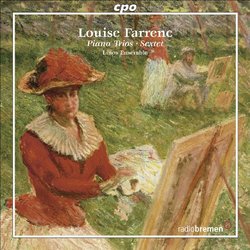| All Artists: Farrenc, Linos Ensemble Title: Louise Farrenc: Piano Trios, Sextet Members Wishing: 1 Total Copies: 0 Label: Cpo Records Release Date: 5/26/2009 Genre: Classical Styles: Chamber Music, Historical Periods, Classical (c.1770-1830) Number of Discs: 1 SwapaCD Credits: 1 UPC: 761203725625 |
Search - Farrenc, Linos Ensemble :: Louise Farrenc: Piano Trios, Sextet
CD Details |
CD ReviewsWhat a Find! J Scott Morrison | Middlebury VT, USA | 06/22/2009 (5 out of 5 stars) "[First, a tip of the hat to the ever-enterprising cpo label, whose issues of otherwise unknown Romantic-era music has been such a boon for those of us who love that era and wish there more access to unfamiliar music of the period. Thank you, cpo!]
Louise Farrenc (1804-1875; by the way the jewel case erroneously gives her dates as 1789-1826) must be counted among the marvels of the middle nineteenth century. She grew up in a family (and in an area of Paris) that was a hotbed of artistic talent. She studied with Antonín Reicha, became the first and only woman to be a full faculty member of the Paris Conservatoire during the whole of the 19th century, was a virtuoso pianist and, best of all for those of us who live 150 years later, a first-rate composer. Previously I reviewed a CD devoted to her chamber music Louise Farrenc: Musique de chambre, having been bowled over by it. Now comes another chamber music disc, this one containing two piano trios (one for clarinet, cello and piano, the other in the usual configuration) and a sextet for piano and wind quintet (amazingly, at least according to the accompanying notes and 'as far as is currently known', the first of its kind in music history -- she had the good sense to add a flute to the usual oboe, clarinet, bassoon and horn). The Piano Trio No. 1, Op. 33, in E Flat Major, is for violin, cello and piano. It is in the usual four movements with a bustling Allegro, a serene Adagio molto, a dynamic Scherzo and, somewhat unusually, a Finale that is a tarantella. There is skillful counterpoint, virtuosic piano figuration and high spirits throughout. Superficially it may sound a bit like Mendelssohn who was, of course, a contemporary, but there are bits that sound a little like Schumann in one of his unbuttoned moods. There is no doubt that the demanding piano part is the primus inter pares, not surprising when one considers that Farrenc wrote the Trio for her own use. It was never published but was played many times in private concerts, a fashionable sort of event in mid-19th century Paris. Next on the disc comes the Sextet for piano and wind quintet. Surely the impetus for this comes at least partly from having studied with Reicha who was a master of woodwind ensemble music. The work could be considered in all but name a piano concerto with the winds taking the part of the orchestra. Adding to this impression is that the work is in the three movements typical of a concerto. The first movement, at twelve minutes twice the length of each of the other movements, is a grand edifice of grandiose sentiments leavened by the sparkling piano. The Andante sostenuto movement features much solo work by the individual winds to chordal accompaniment. Here the piano has cantilenas reminisicent of Bellini or Chopin. Beautiful melodic ideas abound. In the brilliant finale the piano shines, with playful figures often imitated then by the upper two winds. The effect of the movement is that of adolescent hi-jinks. The Piano Trio No. 3, Op. 44, in E Flat Major, for clarinet, cello and piano was written in the late 1850s. It can also be played with a flute in place of the clarinet, but it seems to me that the music better fits clarinet at least partly because of its occasional use of the clarinet's distinctive chalumeau register. It has four movements and lasts a little over twenty minutes. The clarinet has a more prominent role than the violin does in the first trio, not surprising when one considers its distinctive timbre. One is reminded at times of Mozart's 'Kegelstatt' Trio, also for clarinet, cello and piano. This trio is mildly disappointing in that it sounds as if it could have been written fifty years earlier, although at the distance of more than 150 years this probably makes little difference to the modern listener. Certainly one cannot quarrel with the performance recorded here. The same is certainly true of the other performances, all of which feature the fine musicianship of pianist Konstanze Eickhorst. Once again we have learned that Louise Farrenc is a name to be reckoned with when considering chamber music of the middle part of the nineteenth century. A hearty recommendation. Scott Morrison" |

